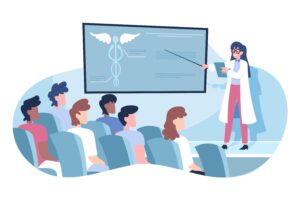Program Title: Graduate Educators Program (GEP)

Program Overview
The Graduate Educators Program (GEP) is designed to empower graduates to serve as peer educators. By delivering classes and workshops to current students across various courses, graduates not only reinforce their own knowledge and gain valuable teaching experience but also enrich the learning environment with practical insights from their professional journey.
Objectives
Enhance Teaching Skills: Equip graduates with modern teaching methodologies, effective communication, and classroom management techniques.
Practical Learning: Bridge the gap between theoretical knowledge and practical applications by sharing real-world experiences.
Professional Development: Provide graduates with an opportunity to develop leadership, public speaking, and organizational skills.
Mentorship: Establish a mentoring system where experienced faculty guide the graduates, ensuring quality and consistency.
Collaborative Learning Environment: Foster a culture of peer-to-peer learning that benefits both the educators and the students.
Eligibility & Selection Process :
Eligibility: Graduates holding degrees in GNM, B.Sc. Nursing, or other recognized paramedical courses.
Application: Interested candidates submit an application highlighting their academic background, clinical experience, and motivation to teach.
Selection Criteria: Evaluation based on academic performance, communication skills, and a demonstrated interest in education. Shortlisted candidates may be required to participate in an interview or a teaching demo.
Program Structure & Curriculum
A. Orientation Phase
Introduction Workshop: Overview of the program, expectations, and responsibilities.
Mentor Assignment: Each selected graduate is paired with a faculty mentor for personalized guidance.
B. Training Workshops
Pedagogy & Adult Learning: Training sessions on adult learning theories and instructional design.
Communication & Public Speaking: Workshops to build confidence and effective communication techniques.
Technology in Teaching: Introduction to digital tools and multimedia resources for enhanced teaching delivery.
C. Teaching Assignments
Module Design: Graduates work with faculty to design specific modules or sessions that complement the existing curriculum.
Classroom Sessions: Conduct regular classes or workshops covering topics such as clinical procedures, patient care ethics, and case studies.
Interactive Methods: Incorporate group discussions, simulations, and hands-on activities to engage students actively.
D. Feedback & Evaluation
Observation & Feedback: Faculty mentors observe sessions and provide constructive feedback.
Peer & Student Feedback: Use structured evaluation forms for continuous improvement.
Self-Reflection: Graduates maintain reflective logs to assess their teaching progress and set future goals.
Program Duration & Schedule
Duration: The program can be structured to run over one academic semester or an entire academic year.
Weekly Structure:
One day dedicated to workshops/training.
Regular classroom sessions integrated into the academic timetable.
Monthly review meetings with mentors.
6. Resources & Support
Facilities: Designated classrooms or online platforms equipped with audiovisual aids.
Learning Materials: Access to teaching resources, case studies, and simulation tools.
Administrative Support: Coordination team to schedule sessions, manage feedback, and oversee program logistics.
7. Certification & Recognition
Completion Certificate: Awarded upon successful completion of the program, highlighting the teaching experience gained.
Incentives: Potential academic credits, professional development points, and recognition within the institution.
8. Implementation Roadmap
Stakeholder Meeting: Engage key stakeholders (faculty, administration, and alumni) to refine program goals and requirements.
Pilot Phase: Launch a pilot with a small group to gather feedback and make necessary adjustments.
Full-Scale Rollout: Implement the program across all eligible courses following the pilot phase.
- Continuous Improvement: Regularly update the curriculum based on feedback from educators and students.